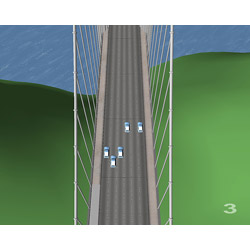
Working Memory: Spatial Encoding (CODING) Module
Model 65318
CODING is a program for training monitoring processes and spatial coding in visuospatial working memory.
Setting and Task
The client observes vehicles driving onto a bridge (memorizing phase). While driving over the bridge the vehicles disappear from the client's view (rehearsal phase). When they reappear at the end of the bridge, one of the vehicles may have changed its position in the spatial arrangement. This vehicle must be identified (recall phase) - this involves comparing the new arrangement of the vehicles as they leave the bridge with the stored layout of their previous arrangement and scanning the new arrangement for differences.
Theory
Both monitoring and coding are base mechanisms of working memory. They are used for (metacognitive) control and coordination of cognitive processes and form the basis for more complex cognitive activities. Monitoring in working memory involves the controlled supervision of storage processes and stored representations. Storage in spatial working memory requires the coding of incoming information according to its spatial features: the location at which the stimuli were perceived and/or their spatial arrangement is stored. Spatial coding links the individual items to representations (binding) and gives them a structure. There is no "pure" representation of a visually perceived stimulus; each stimulus also has a spatial "code".
For example, the information that a driver obtains by looking in his rear-view mirror is incorporated into the stored image of the driving environment. More complex examples include following assembly instructions or wiring diagrams, creating mind maps, or working with multiple open windows on a computer.
Difficulty Structure
CODING has 21 difficulty levels. At the different difficulty levels different storage and retrieval strategies are required, ranging from the identification of errors to reconstruction of the original sequence and the correction of errors. The demands on monitoring processes increase throughout the program.
The lower difficulty levels train the monitoring skills required to identify errors: the client must decide whether or not the arrangement of the vehicles shows changes/errors (yes/no answers). Later the client must click on the vehicle that has changed its position within the spatial arrangement. Finally at the highest level the difficulty is increased by the disappearance at the recall stage of the spatial structures between the vehicles; the scene must be reconstructed from memory. At this level the client must dissolve his binding of the entire spatial structure.
The program is adaptive: because the client is constantly working at the limit of his individual ability, there is little scope for automated processing - controlled monitoring must therefore be continuously applied.
